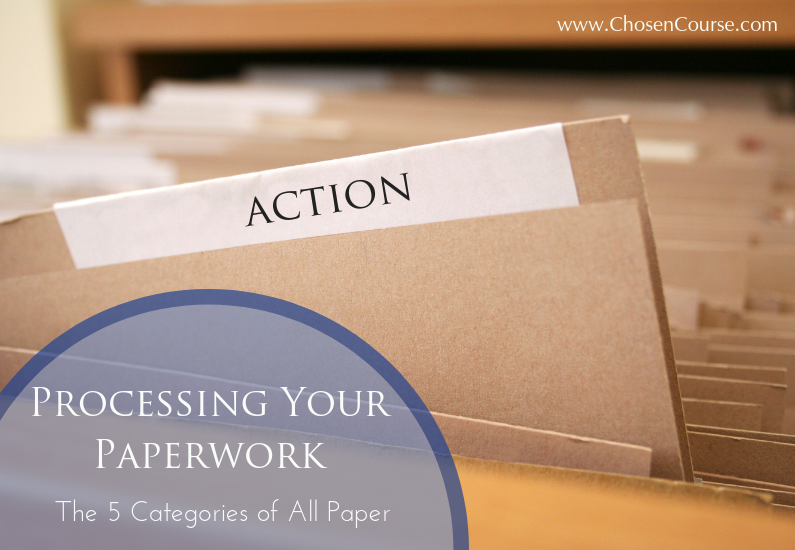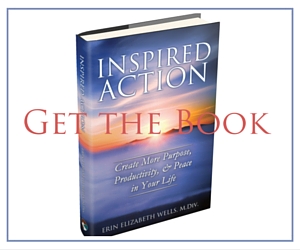It’s finally happening… we’re going “Paperless.” Well, more even more “Paper-less” than before as an outgrowth of our move to digital nomad. The time has come to shift fully into “paper-free” life as we leave our file drawers and printer behind. We’re shredding all our existing files, downloading digital copies of our financial statements, and scanning to Dropbox or Evernote virtually everything that we might want to access again.
Which means that we’ve also been spending a lot of the last few weeks processing through the paper that’s collected in the office and making a lot of drastic decisions about what deserves space in our storage unit (tax archive boxes,) and what is just getting pitched or shredded.
It’s this process in particular that has inspired me to share this excerpt from my book Inspired Action: Create More Purpose, Productivity, and Peace in Your Life. What follows is Chapter 18: BARFT- Managing Your Incoming Paperwork (and yes, the acronym is still makes me giggle since it often feels like paperwork just barfed all over our offices and desks, doesn’t it?)
This is the exact process that I’m using to purge all the paper from our lives (with the exception of adding sub-category of action called “To Scan”.) However, even if you’re not in the process of a MAJOR lifestyle change like we are, this is also the process that I’ve used with my clients for over a decade to process any random sets of paperwork floating around their world. I hope you will be able to use it to start getting your random paperwork under better control!
Chapter 18: BARFT- Managing Your Incoming Paperwork
Paper, paper, there’s always more paper! With the introduction of tablet computers, the amount of paper in people’s lives is finally lessening a bit. However, during my years as a professional organizer, the number-one issue that our clients have repeatedly identified is managing the mountain of paperwork that is part of their daily lives. I remember futurists of the 1990s predicting that with the increasing popularity of the personal computer, paper would soon be history. Instead, computers made it easier to print everything! As a result, most of us have more paper in our lives than any previous generation did.
What’s so tricky about paperwork is that for a given stack of it on the corner of your desk, you might need to make anywhere from 10 to 200 decisions to make that paper end up elsewhere. We frequently tell clients to be prepared for the fact that organizing paperwork tends to be both challenging and slow. If you think about it, four inches of height on a shelf in a closet might hold two to four sweaters and thus require only two to four decisions. The same space of paperwork on your desk, however, is a couple reams of paper that need individual attention. So, begin with patience…and a deep breath.
BARFT: Five Categories for All Paperwork
At this point, I’m pleased to tell you that essentially every sheet of paper in your world falls into one of five categories, which I have unattractively coined as BARFT. While it’s not the prettiest acronym in the world, many of us feel rather like our paperwork has barfed all over our lives, so at least it’s accurate.
Bills to Pay
I always like to start here because of all the papers in your life, bills are items for which your failure to find and act on them can negatively impact your bank account, your credit score, or both. Bills deserve their own special place and category.
Action Items
This type of paperwork includes forms you have to complete and return, services or products that you want to research, and notes from your child’s teacher that require a response. Basically, action items are papers that require you to take a follow-up action before you can pitch it or file it. If you’re using a task management system, then you might also want to build a habit of recording the necessary action on your master list before putting the papers into your Action Items file or bin. That will ensure that you have a reminder of the task in a useful location rather than relying on the paper itself to be your reminder. For more information about setting up your master list see Chapters 23 and 24 of Inspired Action.
Read
This is where all those catalogs, magazines, newsletters, and reports belong—those lovely, bulky items that you want to curl up and flip through at some time in the near future. I encourage you to get very clear about what’s realistic to keep in this category. I have seen “To Read” piles that are several feet high—or occasionally, with some of our hoarding clients, entire houses or rooms full of paperwork that the client wanted to read someday. Set a limit. It could be a spatial limit (no bigger than a designated basket) or a time limit (if I haven’t gotten to it in X weeks or months, then it can’t be that important to my life.) Either way, don’t let the “shoulda-coulda-woulda” of the “To Read” mountain take over your environment or your energy.
File
If a piece of paper’s only value is as a reference or in case of future emergency (perhaps your taxes get audited—*shudder*), then it probably just needs to be filed appropriately. Think very carefully before you immediately toss everything in here, though. When would you need this item again, and under what circumstances? Could you find the information easily online or on your computer if necessary? What’s the worst thing that would happen if you didn’t have it? The 80/20 rule often applies to paperwork: people access only 20 percent of their files on 80 percent of the occasions when they search for files. That means 80 percent of our paperwork hangs around our workstations for absolutely no good reason. Don’t accumulate thoughtlessly. Remember: the more you keep, the harder it may be to find what you really do end up needing.
Trash (or Recycling, if You Prefer)
Here’s the truth: all of that paper will eventually end up in the recycling bin. You just get to decide how long a sojourn in your world it will take in the meantime. Perhaps it goes to Action or Read first, or it travels through your filing system until it gets purged. But a significant amount of paperwork can and should go directly into the trash (do not pass go, do not collect $200). Some examples:
- All mailed envelopes. The envelopes that paper arrives in just create bulk. They also mean you have to take time folding and unfolding things before you know what they are. Pitch the envelopes and save time and space.
- Unsolicited junk mail. Unless your response upon looking at it was, “Wow, I’ve been looking for one of those!“ it’s trash. When you need it, you will be able to find it again. Behold the power of the Internet!
- Inserts that come with your bank statements and utility bills. They are essentially the same as the example above: unsolicited junk.
I’m sure I could think of more examples of papers to trash, but perhaps a good suggestion is to set some rules that allow you to make quick decisions about what stays and what goes.
Next Actions
- If you have a pile of random paperwork on your desk, grab four sticky notes and give them the following four titles: Bills, Action, Read, and File. Pull over your recycling bin and start sorting. Every one of the pages in that pile will fit in to one of these categories. It’s time to decide which one.
- Set up a permanent paperwork-processing system. Choose a specific place (basket, bin, folder, or other container—anything other than an unlabeled, drifting pile will suffice) where you will always put each of the four main categories—Bills, Action, Read, and File. Keep a recycling bin or trash can, and a paper shredder (if necessary), near your processing system location.
- Practice, practice. At the end of each day, or when your mail arrives, collect all loose paperwork in your world and practice sorting into the BARFT categories. Once you get used to the system, staying on top of it rarely requires more than five minutes a day. With this processing done, you’ll have your paper information teed up and ready when you are for that bill-paying session, reading, or to knock out a few of your actions items.
For more great productivity tips and tricks, make sure you pick up a copy of Inspired Action today. Its 50 short, actionable chapters will help you get your life feeling more organized and on course quickly.




